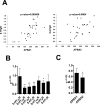Serotonin 6 receptor controls Alzheimer's disease and depression
- PMID: 26449188
- PMCID: PMC4694947
- DOI: 10.18632/oncotarget.5777
Serotonin 6 receptor controls Alzheimer's disease and depression
Abstract
Alzheimer's disease (AD) and depression in late life are one of the most severe health problems in the world disorders. Serotonin 6 receptor (5-HT6R) has caused much interest for potential roles in AD and depression. However, a causative role of perturbed 5-HT6R function between two diseases was poorly defined. In the present study, we found that a 5-HT6R antagonist, SB271036 rescued memory impairment by attenuating the generation of Aβ via the inhibition of γ-secretase activity and the inactivation of astrocytes and microglia in the AD mouse model. It was found that the reduction of serotonin level was significantly recovered by SB271036, which was mediated by an indirect regulation of serotonergic neurons via GABA. Selective serotonin reuptake inhibitor (SSRI), fluoxetine significantly improved cognitive impairment and behavioral changes. In human brain of depression patients, we then identified the potential genes, amyloid beta (A4) precursor protein-binding, family A, member 2 (APBA2), well known AD modulators by integrating datasets from neuropathology, microarray, and RNA seq. studies with correlation analysis tools. And also, it was demonstrated in mouse models and patients of AD. These data indicate functional network of 5-HT6R between AD and depression.
Keywords: 5-HT6R; APBA1/2; Alzheimer’s disease; depression; serotonin.
Conflict of interest statement
The authors declare no competing financial interests.
Figures






Similar articles
-
4-O-methylhonokiol prevents memory impairment in the Tg2576 transgenic mice model of Alzheimer's disease via regulation of β-secretase activity.J Alzheimers Dis. 2012;29(3):677-90. doi: 10.3233/JAD-2012-111835. J Alzheimers Dis. 2012. PMID: 22330831
-
Improvement of cognitive function in Alzheimer's disease model mice by genetic and pharmacological inhibition of the EP(4) receptor.J Neurochem. 2012 Mar;120(5):795-805. doi: 10.1111/j.1471-4159.2011.07567.x. Epub 2012 Jan 23. J Neurochem. 2012. PMID: 22044482
-
Berberine ameliorates β-amyloid pathology, gliosis, and cognitive impairment in an Alzheimer's disease transgenic mouse model.Neurobiol Aging. 2012 Dec;33(12):2903-19. doi: 10.1016/j.neurobiolaging.2012.02.016. Epub 2012 Mar 27. Neurobiol Aging. 2012. PMID: 22459600
-
Alzheimer's disease.Subcell Biochem. 2012;65:329-52. doi: 10.1007/978-94-007-5416-4_14. Subcell Biochem. 2012. PMID: 23225010 Review.
-
Serotonin 5-HT6 receptor antagonists for the treatment of cognitive deficiency in Alzheimer's disease.J Med Chem. 2014 Sep 11;57(17):7160-81. doi: 10.1021/jm5003952. Epub 2014 Jun 3. J Med Chem. 2014. PMID: 24850589 Review.
Cited by
-
Understanding How Physical Exercise Improves Alzheimer's Disease: Cholinergic and Monoaminergic Systems.Front Aging Neurosci. 2022 May 18;14:869507. doi: 10.3389/fnagi.2022.869507. eCollection 2022. Front Aging Neurosci. 2022. PMID: 35663578 Free PMC article. Review.
-
Targeting the brain 5-HT7 receptor to prevent hypomyelination in a rodent model of perinatal white matter injuries.J Neural Transm (Vienna). 2023 Mar;130(3):281-297. doi: 10.1007/s00702-022-02556-8. Epub 2022 Nov 6. J Neural Transm (Vienna). 2023. PMID: 36335540 Free PMC article.
-
5-Hydroxytryptamine receptor 6 antagonist, SB258585 exerts neuroprotection in a rat model of Streptozotocin-induced Alzheimer's disease.Metab Brain Dis. 2018 Aug;33(4):1243-1253. doi: 10.1007/s11011-018-0228-0. Epub 2018 Apr 17. Metab Brain Dis. 2018. PMID: 29667108
-
5-HT6 receptors: Contemporary views on their neurobiological and pharmacological relevance in neuropsychiatric disorders.Dialogues Clin Neurosci. 2025 Dec;27(1):112-128. doi: 10.1080/19585969.2025.2502028. Epub 2025 May 10. Dialogues Clin Neurosci. 2025. PMID: 40347153 Free PMC article. Review.
-
The interaction of early life factors and depression-associated loci affecting the age at onset of the depression.Transl Psychiatry. 2022 Jul 25;12(1):294. doi: 10.1038/s41398-022-02042-5. Transl Psychiatry. 2022. PMID: 35879288 Free PMC article.
References
-
- Meltzer CC, Smith G, DeKosky ST, Pollock BG, Mathis CA, Moore RY, Kupfer DJ, Reynolds CF., 3rd Serotonin in aging, late-life depression, and Alzheimer’s disease: the emerging role of functional imaging. Neuropsychopharmacology. 1998;18:407–430. - PubMed
-
- Parmelee PA, Katz IR, Lawton MP. Depression among institutionalized aged: assessment and prevalence estimation. J Gerontol. 1989;44:M22–29. - PubMed
-
- Green RC, Cupples LA, Kurz A, Auerbach S, Go R, Sadovnick D, Duara R, Kukull WA, Chui H, Edeki T, Griffith PA, Friedland RP, Bachman D, Farrer L. Depression as a risk factor for Alzheimer disease: the MIRAGE Study. Arch Neurol. 2003;60:753–759. - PubMed
-
- Rapp MA, Schnaider-Beeri M, Grossman HT, Sano M, Perl DP, Purohit DP, Gorman JM, Haroutunian V. Increased hippocampal plaques and tangles in patients with Alzheimer disease with a lifetime history of major depression. Arch Gen Psychiatry. 2006;63:161–167. - PubMed
Publication types
MeSH terms
Substances
LinkOut - more resources
Full Text Sources
Other Literature Sources
Medical

